- Get link
- X
- Other Apps
Types of Batteries – Choosing the Right Power Source
Batteries come in various types, each with distinct properties suitable for different devices and uses. Here’s a breakdown of some common battery types and their applications.
1. Alkaline Batteries
- Usage: Common in household items like remote controls and clocks.
- Pros: Long shelf life and safe for everyday use.
- Cons: Non-rechargeable and produces waste after a single-use cycle.
2. Lithium-Ion Batteries
- Usage: Widely used in smartphones, laptops, and electric vehicles.
- Pros: Lightweight, high energy density, and rechargeable.
- Cons: Sensitive to high temperatures and can degrade over time.
3. Lead-Acid Batteries
- Usage: Used in vehicles and backup power systems.
- Pros: Affordable and durable, with a high power output.
- Cons: Heavy and requires regular maintenance.
4. Nickel-Cadmium (NiCd) Batteries
- Usage: Older devices, power tools, and medical equipment.
- Pros: Long life cycle and can work under extreme temperatures.
- Cons: Contains toxic cadmium and suffers from a “memory effect.”
5. Nickel-Metal Hydride (NiMH) Batteries
- Usage: Digital cameras, toys, and portable electronic devices.
- Pros: Environmentally friendly and has a higher capacity than NiCd.
- Cons: Self-discharges faster and less efficient at high currents.
Choosing the Right Battery for Your Needs:
Each battery type has specific advantages and is suited for different applications. Consider device requirements, environmental impact, and durability when selecting a battery.
In conclusion, understanding the types of batteries and their properties can help you make informed choices for safer and more efficient power solutions.
#AlkalineBattery
#BatteryGuide
#BatteryTypes
#LeadAcidBattery
#LithiumIonBattery
#NickelCadmiumBattery
#NickelMetalHydrideBattery
#TypesOfBatteries
- Get link
- X
- Other Apps


Comments
Post a Comment